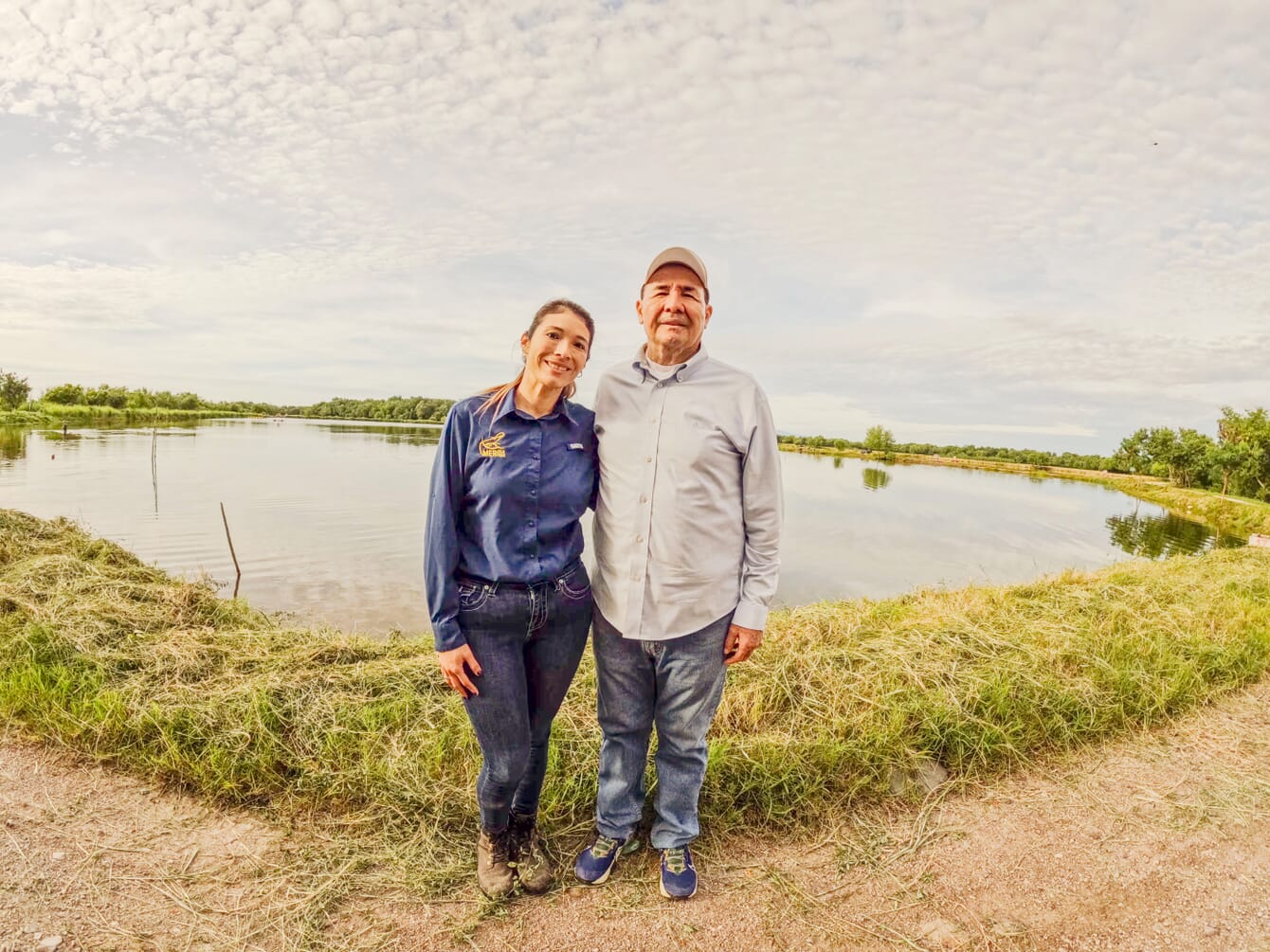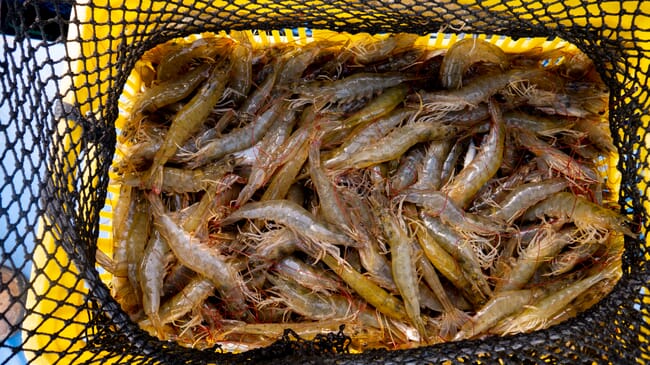
© MER Seafood
Rivera, who has spent a decade in the company that was established – and is still run – by her father Efrain, believes that the days are numbered for family-owned farms like hers, unless the market changes.
While shrimp farmers from around the world are feeling the pinch, Rivera notes that it’s particularly tough to stay afloat in Honduras, where feed, energy and labour costs are all much higher than many of the other shrimp producing nations.
“It doesn’t match with the global shrimp price, so our margins are getting lower and lower,” she reflects.
And she adds that companies such as hers, that are following best practices, are likely to be hit the hardest.
“We’re getting all these costly certifications, but the market is not willing to pay extra. As consumers we need to pay more for products that are ASC-certified, humanely slaughter and come from a BAP hatchery and a three-star processing plant,” Rivera explains.
“I don’t think we’ll ever return to those golden years of 20 years ago but I think there could be more differentiation – that if I’m doing my part for sustainability and am gaining certifications that cost me money, I should have a distinguishing price. We have to educate the public to know what we’re doing and to support our farmers,” she adds.
However, if prices don’t improve Rivera is concerned about the future of the family business.
“If the price doesn't change the small and medium farmers will be absorbed by the big companies. My goal has never been to sell my shrimp in Costco or Walmart – not because I don’t want to but because I know it’s not feasible. My goal is to educate sellers why we cost more. If the public want to buy cheap shrimp, they have to know what that means,” she argues.
It an issue that is being exacerbated by the huge production increase in Ecuador.
“The fact that they’ve grown so rapidly and have such a low cost of production has a trickle-down effect for all of us,” she observes.
A solid foundation, but...
Rivera’s story is all the more alarming as Rivermar is by no means the sort of bit-part operator who one pictures as being the usual victim of consolidation.
Indeed, the company currently farms across 400 ha and produced 1,900 tonnes of shrimp last year. They also employ around 150 people, and – according to Rivera – they don’t just provide jobs in the community, but also help with their health and welfare, partnering with NGOs.
With margins so tight, Rivermar are in the process of trying to improve their efficiencies and they expect to reach 2,700 tonnes by 2025, following a program of technification, involving the roll-out of aerators and automatic feeders in their ponds.
“We’ve done this because we don’t have a lot of land to expand. And though we’ve explored the idea of going hyper-intensive, it’s a very, very expensive system and we feel it won’t work for us. We feel it’s better to be semi-intensive: we feel it’s better to grow slow and steady. It’s worked for us and there’s no venture capital in our company,” she notes.
It’s also in keeping with their openness to innovation, according to Rivera, who notes that they were the first shrimp farmer in Latin America to trial – and subsequently adopt – Optimar’s electrical stunning machines.

© MER Seafood
From cheese to crustaceans
It was purely by chance that the Rivera family took up shrimp farming: her father bought land to for ranching dairy cattle in the early 1990s, but the high salinity levels made it impossible for him to establish pastures. As a result, in 1996, he decided to explore the potential of shrimp farming, which was only just emerging as an industry in the region.
“I was almost 10 and my little sister almost five, but we thought it was the greatest summer ever, spending time with our dad marking out the lagoon where we were going to seed the shrimp,” Rivera recalls.
In the decades that followed they gradually grew production and, by 2014, Rivera was ready to join the family firm, not least as she believed that the business model was in need of a change.
“That’s when I realised how big we’d grown and I started telling my father that we needed to start doing things differently. What he’d been doing was producing shrimp and selling it to the processing plants,” she recalls.
As a result she began to investigate growing the sales side of the business – establishing MER Seafood – going to trade shows, speaking to potential clients and inviting them to visit the farm. A move to Japan two years later helped her realise the market opportunities in Asia and soon – thanks to her growing Asian network – the company was selling a significant proportion of their shrimp on Taiwan’s premium shrimp market.
It was in 2017, Efrain decided to establish his own inland hatchery, Rilarvi, in a bid to improve the consistency of post-larvae (PL) quality – having become fed up with the mixed quality of imports from hatcheries in countries including Panama, Peru, Thailand and the US.

© MER Seafood
The success of the hatchery and growing demand for certified PLs persuaded the family to double its size this year, giving them the possibility of selling PLs to other producers in the area too – including exports to Nicaragua – although 85 percent of them are stocked directly into their own ponds.
After a few years of running the hatchery Efrain decided not to ablate his female broodstock, going against the industry norms. After a series of trials they switched entirely to non-ablated broodstock by 2021 and haven’t looked back – not least as being ablation-free is now a prerequisite for BAP hatchery certification.
According to Rivera it’s part of her father’s respect for nature. It’s the same respect that he showed by retaining the mangroves along the farm’s coastline – a move that meant they were one of the few farms in the region not to be destroyed by Hurricane Mitch in 1998, as the mangroves protected them from the worst of the tidal surge.
Other challenges
Following a spat between the Honduran and Taiwanese governments in 2023, which shut down the free trade agreement between the two countries, MER have had to rethink their sales strategy. While they have managed to pivot to markets in Mexico, the UK, France and China, Rivera notes that the Taiwan debacle has put many shrimp companies out of business.
“We’ve seen packaging companies closing their doors. We’ve seen a lot of layoffs. A lot of small farms didn’t seed and are continuing not to seed. We’ve seen big companies buying smaller ones. Yes, we’re developing the Chinese market but you don’t develop a market overnight, even if both governments are supporting you. There’s more to it: not only price, there’s the logistics of exportation, requirements, paperwork. In reality as farmers we have zero say in geopolitical situations,” she points out.
And it’s not just the shrimp farmers who are being affected – Rivera has seen a huge drain on human capital since then, with more and more educated Hondurans attempting to emigrate to countries such as the US – pushed out by gangs and cartels and attracted by the lure of a better life.
It’s affecting Rivermar directly too, and Rivera has seen many of their most talented employees leaving in search of better lives abroad.
“This is why we want to create a sustainable and generational industry,” she reflects.
Looking ahead
Although Rivera’s concerned about the stability of so many shrimp farms, including her own, she has faith that the Global Shrimp Council – of which she’s a founding board member – will help to drive greater demand for shrimp across the world.
“I think the importance of the council is to ask our consumers to eat more shrimp, because it’s such a delicious and healthy protein,” she reflects.
Meanwhile, on a personal level, she’ll be looking to develop more and more niche markets, in order to ensure that the company can align its harvests and shrimp quality with the most suitable buyers.
And she also hopes that she’ll help Rivermar shrimp cross the border to the US, not least to keep her own children happy.
“My kids love their grandfather’s shrimp and they can’t wait to have it in the US,” she concludes.




